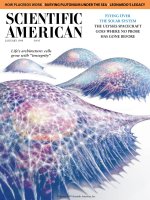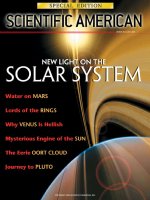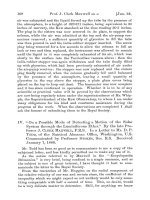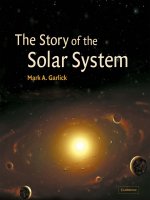- Trang chủ >>
- THPT Quốc Gia >>
- Hóa
The solar system and beyond
Bạn đang xem bản rút gọn của tài liệu. Xem và tải ngay bản đầy đủ của tài liệu tại đây (2.84 MB, 8 trang )
Earth Sciences
Standards
Preview
Standard Set 4. Earth Sciences
4. Objects in the sky move in regular
and predictable patterns. As a basis
for understanding this concept:
4.a. Students know the patterns of
stars stay the same, although they
appear to move across the sky nightly,
and different stars can be seen in
different seasons.
Genre
Nonfiction
Comprehension Skill
Predict
4.c. Students know telescopes magnify
the appearance of some distant
objects in the sky, including the Moon
and the planets. The number of stars
that can be seen through a telescope is
dramatically greater than the number
that can be seen by the unaided eye.
4.d. Students know that Earth is one of
several planets that orbit the Sun and
that the Moon orbits Earth.
Text Features
• Captions
• Labels
• Glossary
Science Content
Objects in Space
Scott Foresman Science 3.6
ISBN 0-328-23534-2
ì<(sk$m)=cdfdeg< +^-Ä-U-Ä-U
by Lillian Duggan
Vocabulary
asteroid
binoculars
orbit
planet
solar system
star
telescope
by Lillian Duggan
Picture Credits
Every effort has been made to secure permission and provide appropriate credit for photographic material. The
publisher deeply regrets any omission and pledges to correct errors called to its attention in subsequent editions.
Unless otherwise acknowledged, all photographs are the copyright of Dorling Kindersley, a division of Pearson.
ISBN: 0-328-23534-2
Copyright © Pearson Education, Inc. All Rights Reserved. Printed in the United States of America.
This publication is protected by Copyright, and permission should be obtained from the publisher prior to any
prohibited reproduction, storage in a retrieval system, or transmission in any form by any means, electronic,
mechanical, photocopying, recording, or likewise. For information regarding permission(s), write to
Permissions Department, Scott Foresman, 1900 East Lake Avenue, Glenview, Illinois 60025.
1 2 3 4 5 6 7 8 9 10 V010 13 12 11 10 09 08 07 06
The Sun
A star is a huge ball of hot, glowing gases. The Sun is
a star. The width of the Sun is equal to the width of 100
Earths placed side by side. The Sun is extremely hot. The
surface of the Sun has a temperature of about 5,500ºC.
Temperatures at the center of the Sun are much hotter.
The Sun’s center is much
hotter than the surface.
The Sun is closer to Earth than any other star. This
makes the Sun look larger and brighter than any other
star. Other stars look smaller than the Sun because they
are much farther away.
Earth and other objects move around the Sun in
patterns. The Sun causes these patterns. The movement
of the Earth makes it hard to figure out these patterns. It
took many years for scientists to figure them out.
The Sun looks large and bright in the sky.
Other stars look much smaller.
Temperatures on the
Sun’s surface reach 5,500ºC.
2
3
Objects in the Solar System
Planets of the Solar System
A planet is a large body of matter that travels around
the Sun. Planets and other objects that travel around the
Sun move in regular patterns that can be predicted. The
path an object takes as it moves around the Sun is its
orbit. Each planet’s orbit has a slightly oval shape.
The Sun, the planets and their moons, and other
objects that orbit the Sun make up the solar system. At
the center of the solar system is the Sun. The strong pull
of the Sun’s gravity keeps the planets orbiting.
The planets closest to the Sun are Mercury, Venus,
Earth, and Mars. The planets farthest from the Sun are
Jupiter, Saturn, Uranus, and Neptune. In 2006, scientists
decided to call Pluto a “dwarf planet.” The closest planets
orbit the Sun faster than the farthest planets.
Between Mars and Jupiter are thousands of objects
that are smaller than the planets. These are asteroids. An
asteroid is a large mass of rock. Asteroids orbit the Sun.
This diagram shows the solar
system’s features. The distances
and sizes are not true to scale.
Asteroid Belt
Jupiter
Uranus
Neptune
Venus
Mercury
Earth
Mars
4
Saturn
5
The Motion of the Moon
The Moon makes one complete turn on its axis in
27 Earth days. It orbits Earth once in about the same
amount of time.
Because the Moon turns so slowly on its axis, the
same side of the Moon always faces Earth. Whenever
you look at the Moon, you always see the same side of it.
People saw the far side of the Moon for the first time in
1959 when a spacecraft took pictures of it.
In the time that the Moon takes
to orbit Earth, it also makes a
turn on its axis.
6
The Moon is the closest object to Earth in space.
Other than the Sun, the Moon is the brightest object
in the sky. The Moon does not make its own light. It
appears lit because sunlight shines on it. This light is
reflected to Earth.
The picture below shows how Earth and the Moon
appear from space. Each night we see a different amount
of the lit part of the Moon.
Several planets move across the fixed pattern of stars.
Like the Moon, these planets reflect light from the Sun.
The moonlight we see from
Earth is reflected sunlight.
7
Studying Objects
In Space
A telescope is a tool for making distant objects
appear nearer and larger. Many telescopes use pieces of
glass called lenses to bend light. Telescopes with large,
curved mirrors can collect larger amounts of light. The
light is directed to a lens to create a bright image.
Binoculars are two telescopes joined together as a
unit. The image you see through binoculars is sharp and
clear. However, binoculars cannot magnify objects as
much as telescopes can.
Using a telescope
or high-powered
binoculars, you can
see Saturn’s rings.
8
Studying the Planets
Mercury, Venus, Mars, Jupiter, and Saturn can all be
seen without a telescope. But you need binoculars and
telescopes to see things on the planets’ surfaces. For
example, Mars has polar ice caps. With a telescope, you
can see them clearly against the planet’s red soil.
The details of Uranus and Neptune are too far away
to be seen even with a telescope. We have learned about
the features of these planets from space probes. These
probes have taken pictures and made measurements.
With a telescope you can see
Jupiter’s clouds. You can also
see four of Jupiter’s moons.
Neptune has rings. At
times, clouds appear on
its surface.
9
Looking at Stars and Galaxies
Comparing Stars
Suppose you’re outside on a clear, dark night. You
look up to see thousands of tiny stars. Through a
telescope you can see even more stars. These stars are
different in size, color, and brightness. Sometimes a
galaxy will look like a star. A galaxy is a group of stars,
dust, and gas that are in the same area.
You might think at first that the brightest stars are
closer than the ones that are less bright. But stars differ
in size and make different amounts of light. Sometimes
smaller stars make more light than bigger ones. Stars
that appear dim may be closer to Earth than stars that
appear bright.
If you view the Andromeda
galaxy without a telescope,
it looks like a small, blurry star.
The stars in this group have
different colors and sizes.
10
11
Glossary
What did you learn?
asteroid
a large piece of rock that orbits the Sun
1. Why does the Sun appear bigger and brighter than
other stars in the night sky?
binoculars
two telescopes joined together as a unit
2. What objects orbit the Sun between Mars and Jupiter?
orbit
the path an object takes as it moves
around the Sun
3. How and when were people able to see the far side of
the Moon for the first time?
planet
a large body of matter that revolves
around a star such as the Sun
solar system
a system made up of the Sun, the
planets and their moons, and other
objects that orbit the Sun
star
a huge ball of hot, glowing gases
telescope
a tool for making distant objects appear
nearer and larger
12
4.
Write a paragraph that
describes how a telescope changes the appearance of
objects. Include simple supporting facts and details.
5.
Predict Would the orbit time for any planet
farther from the Sun than Neptune be longer or shorter
than the time it takes Neptune to orbit?









